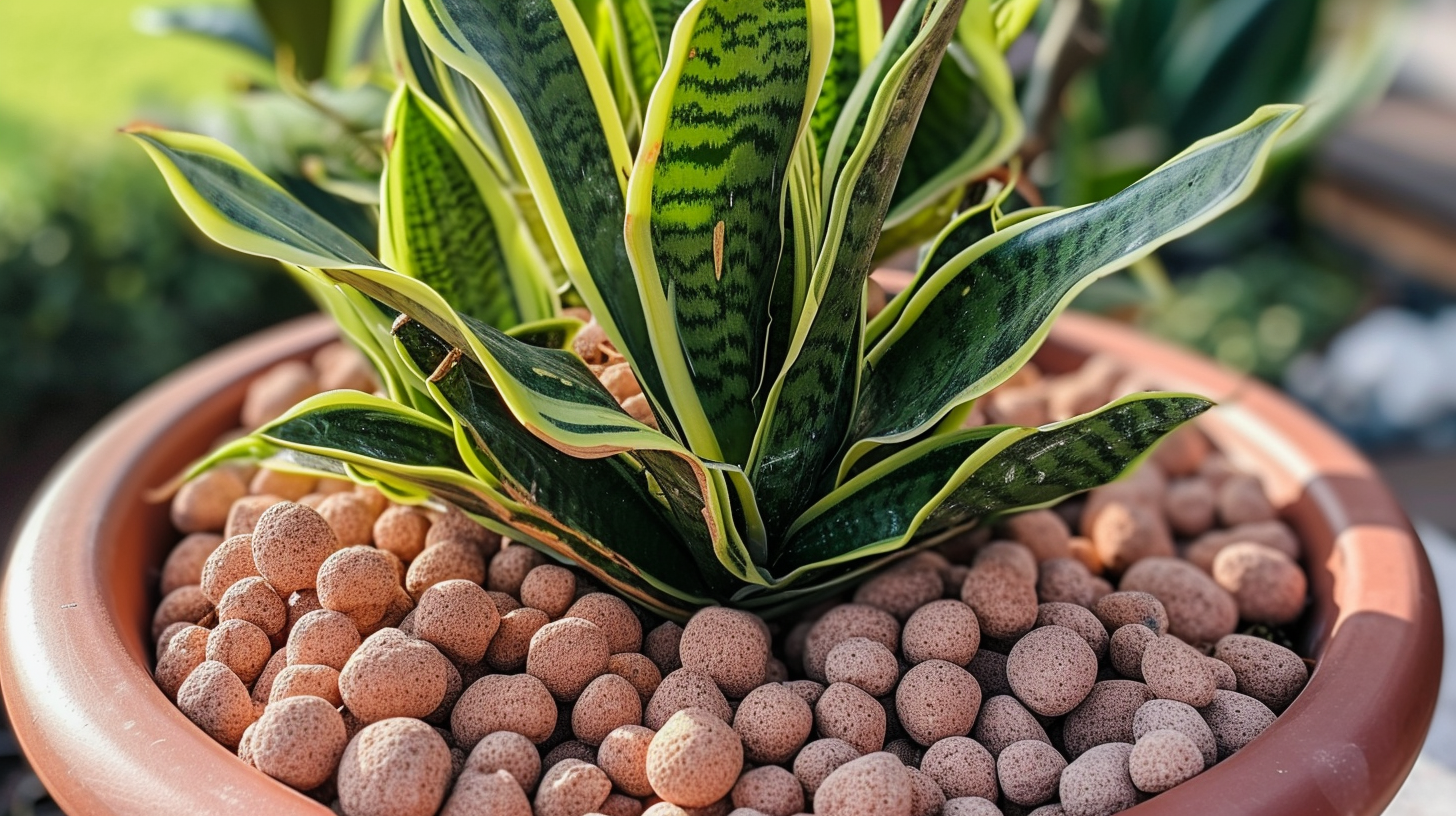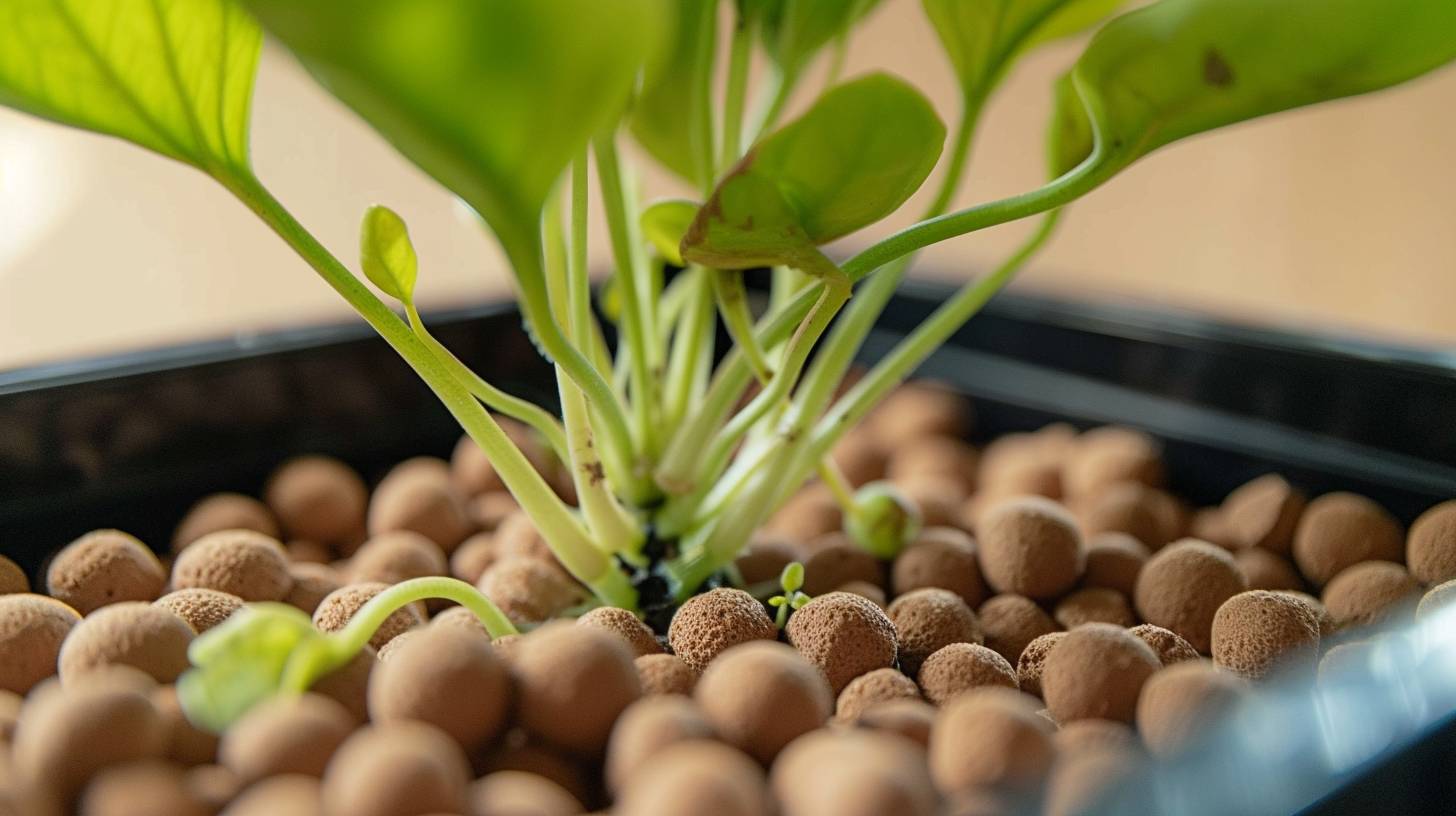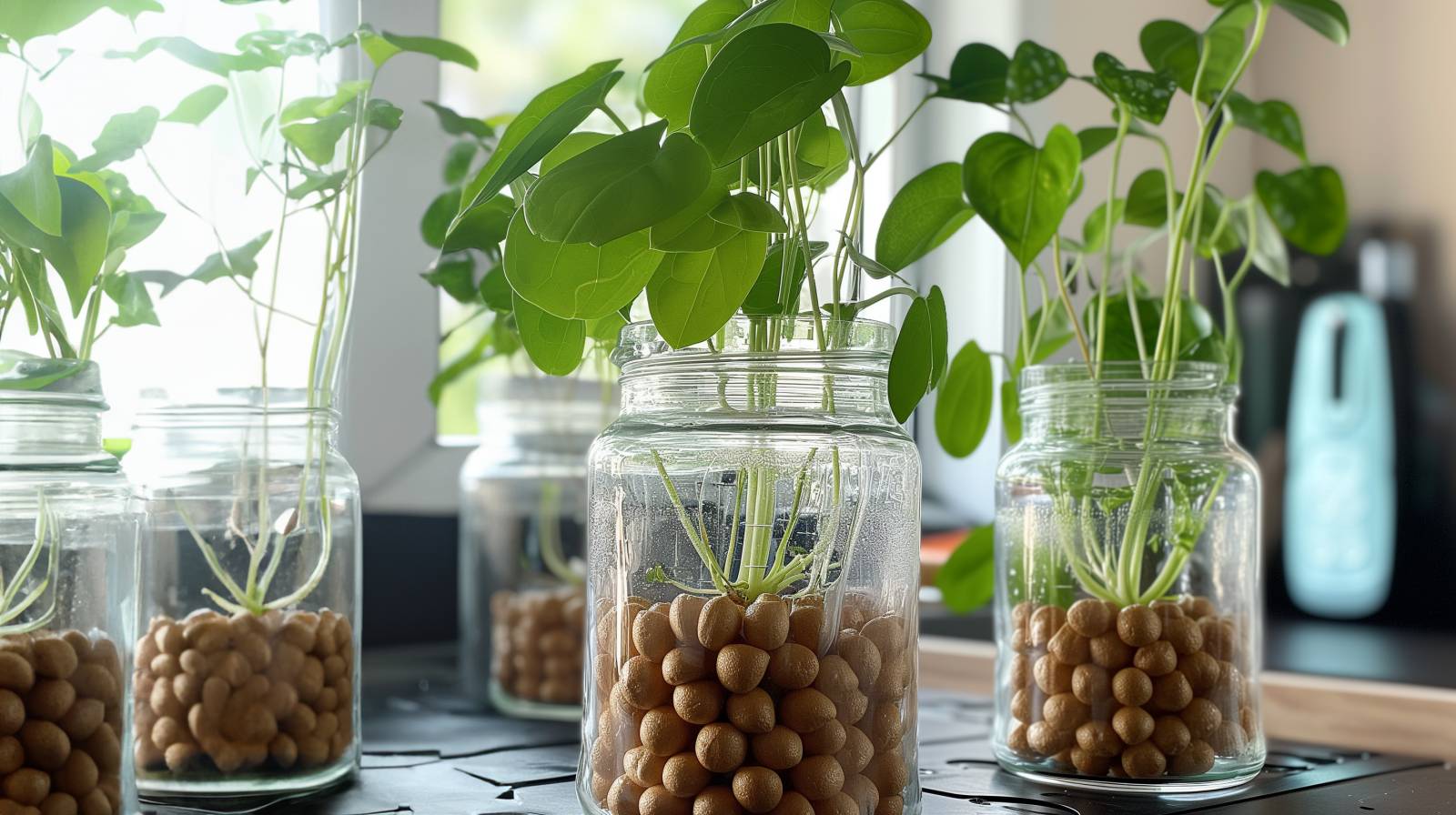Discovering the world of LECA, or Lightweight Expanded Clay Aggregate, has revolutionized the way I care for my plants.
Table of Contents
ToggleDid you know that LECA balls are not only lightweight but also offer excellent aeration and moisture retention for roots?
The benefits of using LECA extend beyond just these factors.
Stay tuned to uncover how this simple yet powerful tool can transform your plant care routine and pave the way for healthier, more resilient greenery in your indoor jungle!
Key Takeaways
- LECA provides optimal water and oxygen balance for plant growth.
- It prevents pests, requires less space, and simplifies watering routines.
- Transitioning to LECA means paying extra attention to watering and fertilizing adjustments.
- Some plants will do better in LECA than others.
Understanding LECA Basics
LECA, or Lightweight Expanded Clay Aggregate, serves as an exceptional growing medium for plants. It offers a well-draining and aerated environment that aids in root development.
Leca’s impact on watering routines, its ability to deter pests, and its role in maintaining plant health are key factors to consider.
Watering
Regularly monitoring water levels in the porous LECA medium is essential for maintaining optimal hydration levels for plants grown in this unique clay ball substrate.
Here are key points to keep in mind:
- LECA absorbs and releases water gradually, aiding in preventing issues like root rot.
- Proper water levels in LECA help avoid overwatering, promoting healthier plant growth.
- The porous nature of LECA ensures adequate air circulation around plant roots during watering.
- Monitoring water levels diligently is vital to provide plants with the right amount of hydration and prevent water-related problems.
Pests
To maintain a pest-resistant environment for your plants, understanding the non-organic composition of LECA is key. LECA, being non-organic, deters pests like soil-borne pests from infesting plant roots. The inert environment provided by LECA makes it less favorable for pests to thrive, reducing the risk of pest-related harm to plant health.
Plant Health
Understanding the benefits of using LECA in plant care extends beyond promoting root health and preventing pests, creating an environment that enhances overall plant vitality and well-being.
When it comes to plant health, LECA offers several advantages:
- Healthy Roots: LECA promotes better root health by preventing waterlogging and root rot.
- Optimized Watering: It allows for controlled watering, reducing the risk of overwatering and helping plants thrive.
- Pest Prevention: By maintaining consistent moisture levels, LECA creates a pest-free environment for plants.
- Thriving Plant Environment: LECA encourages root development, simplifies care routines, and supports various plant species in thriving conditions.
With these benefits, LECA becomes a valuable ally in ensuring the health and well-being of your plants.

Watering Advantages and Hurdles
Watering becomes more manageable with LECA due to its transparent nature allowing for easy monitoring of water levels and prevention of root rot. While LECA offers numerous advantages in watering, challenges like algae growth and the need for hydroponic nutrients can arise. Here is a table to summarize the watering advantages and hurdles of using LECA:
| Advantages | Hurdles | Tips |
|---|---|---|
| Easy water level monitoring | Algae growth in clear pots | Regular water changes to prevent algae growth |
| Prevention of root rot | Requirement of hydroponic nutrients | Use hydroponic nutrients to avoid odors in the setup |
| Facilitates synchronized watering | Monitoring plant signals for issues | Pay attention to plant signals for optimal care |
Managing watering with LECA involves vigilance to prevent issues like algae growth and nutrient deficiencies, ensuring plants thrive in this unique growing medium.
Care and Problem-Solving
When caring for plants in LECA, it’s crucial to remember that LECA lacks nutrients, requiring additional mineral supplements for optimal growth.
Consider the vessel size to prevent root rot and ensure proper drainage.
Always be attentive to signs of wilting, and maintain plant health by flushing the LECA regularly.
Nutrients
To ensure optimal plant health and growth in LECA, incorporating hydroponic nutrients is essential due to the medium’s lack of natural nutrients. When caring for plants in LECA, consider the following:
- Hydroponics Nutrients: Provide essential minerals and nutrients for plant growth.
- Regular Fertilizer: Not sufficient for plants in LECA due to the medium’s unique requirements.
- Proper Fertilization: Crucial for preventing deficiencies and ensuring healthy plant development.
- Root Rot: Prevented in LECA by the medium’s ability to allow roots to absorb water effectively.
Vessel Size
Select a vessel size that promotes optimal water circulation and prevents water stagnation within the LECA medium to ensure healthy plant growth. The container size plays a crucial role in maintaining the right balance of hydration for your plants’ roots. Containers with adequate drainage holes are essential to prevent waterlogging and root issues.
Be cautious not to choose vessels that are too large, as they can retain excess water, leading to root rot. Regularly monitor the water levels in the vessel to adjust hydration accordingly. Adapting the vessel size based on your plant’s water requirements helps prevent overwatering or underwatering problems in your LECA system.
Root Rot
Optimal water circulation and preventing root issues in your LECA system rely heavily on selecting a vessel size that promotes healthy plant growth and prevents water stagnation. Addressing root rot in Leca involves crucial care practices to ensure the well-being of your plants:
- Proper Drainage: Ensure adequate drainage holes in your container to prevent water buildup.
- Monitoring Moisture Levels: Regularly check the moisture levels in the Leca balls to avoid overwatering.
- Adequate Aeration: Maintain proper airflow around the roots to prevent oxygen deprivation.
- Healthy Hydration Balance: Keep a balanced level of hydration to promote optimal plant growth and prevent root rot issues.
Flushing
Regularly flushing your LECA system is a key maintenance practice to prevent mineral build-up and ensure optimal plant health. Flushing involves dumping old water, rinsing the LECA with fresh nutrient water, and topping up with fresh water. This process helps prevent issues like root rot, algae growth, and pests, ensuring a healthy environment for your plants. Proper flushing of LECA is essential to maintain the longevity and effectiveness of this growing medium. By flushing regularly, you can safeguard your plant’s roots, promote plant health, and prevent potential problems that may arise from mineral accumulation.
| Benefits of Flushing LECA | Importance for Plant Health |
|---|---|
| Prevents mineral build-up | Ensures optimal growth |
| Eliminates root rot risks | Maintains balanced nutrients |
| Reduces algae growth | Promotes healthy roots |
Wilting
Identifying the cause of wilting in plants is crucial for effective care and problem-solving.
- Check soil moisture by feeling the soil with your finger to gauge watering needs.
- Adjust your watering frequency based on plant requirements and environmental factors to prevent wilting.
- Wilting can also result from root issues, nutrient deficiencies, temperature stress, or inadequate light.
- Promptly address wilting by pinpointing the root cause and taking corrective measures to revive the plant’s health.

Economic and Environmental Impact
Transitioning to LECA as a growing medium presents significant economic and environmental benefits for plant enthusiasts and sustainability-conscious individuals.
LECA, or Lightweight Expanded Clay Aggregate, not only offers a reusable alternative to traditional soil but also contributes to reducing waste from disposable soil mixes. By using LECA, plant caregivers can experience long-term cost savings due to its durability and longevity compared to soil.
The production process of LECA involves energy-efficient methods, leading to a lower carbon footprint and aligning with eco-friendly gardening practices. As LECA promotes water conservation in plant care over time, it aids in minimizing water usage, benefiting both the environment and sustainability efforts.
Embracing LECA supports a more environmentally conscious approach to plant cultivation, making it a practical choice for those seeking a balance between plant care effectiveness and eco-friendliness in their gardening practices.
Tips for LECA Cultivation
When cultivating plants with LECA, it’s crucial to prepare the clay balls properly, ensuring they’re clean and free of debris. Sanitizing LECA between uses helps maintain a healthy growing environment for plants.
Considering water pH levels, selecting suitable plants, and monitoring light exposure are key factors for successful LECA cultivation.
Prepare Your LECA
To ensure optimal growth conditions for your plants, it’s crucial to thoroughly rinse your LECA before use, removing any dust and debris to create a clean growing medium.
- Soak LECA in water before planting to hydrate the roots effectively.
- Mix LECA with soil or use it alone to provide excellent aeration and drainage.
- Place a layer of LECA at the bottom of the pot to enhance drainage and prevent waterlogging.
- Monitor moisture levels within the LECA to prevent overwatering and maintain ideal plant growth conditions.
Sanitize Between Uses
To maintain a clean and healthy growing environment for your plants, ensuring to sanitize your LECA between uses is essential for preventing the transfer of pests and diseases. Cleaning the clay balls removes any salt or mineral buildup, which can impact plant health.
Soaking LECA in a mild bleach solution or hydrogen peroxide effectively sanitizes the clay balls. Boiling LECA in water for a few minutes can also disinfect and refresh it for reuse.
Regularly sanitizing your LECA ensures that your plants are in an environment free from harmful contaminants. By incorporating these cleaning practices into your LECA maintenance routine, you can promote the well-being and vitality of your plants.
Consider Your Water PH Levels
The water pH levels are essential for the successful cultivation of plants in LECA, as they directly impact nutrient availability and plant health.
- Regular water pH testing is crucial.
- Optimal pH levels between 5.5 and 6.5 are ideal.
- Proper pH maintenance ensures nutrient availability.
- It promotes optimal nutrient uptake for healthy plant growth.
Maintaining the correct pH level in water is fundamental as it influences the overall well-being and development of plants in a LECA setup. By monitoring and adjusting the water pH levels within the recommended range, you can provide the necessary conditions for your plants to thrive, absorbing the essential nutrients they need for robust and vigorous growth.
Choose The Right Plants
Maintaining the correct pH level in water is fundamental as it influences the overall well-being and development of plants in a LECA setup. When selecting plants for LECA cultivation, opting for those with less dense root systems like pothos or spider plants can ease the transition and enhance their adaptation to this innovative growing medium.
These plants are well-suited for the efficient water absorption and nutrient uptake that LECA provides. It’s crucial to remove all soil from the roots before transferring to LECA to ensure optimal performance. Additionally, using hydroponic fertilizers instead of traditional soil-based nutrients will support the plants’ growth in this new environment, allowing for a successful and thriving hydroponic setup.
Consider Light Levels
When cultivating plants in a LECA setup, ensuring appropriate light levels is essential for promoting optimal growth and overall plant health. Here are some tips to consider:
- Monitor light levels: Regularly check the amount of light your plants receive in their LECA setups.
- Adjust light exposure: Tailor the light exposure based on the plant species’ requirements to maximize growth benefits.
- Promote plant growth: Adequate light exposure helps plants in LECA setups to photosynthesize efficiently, aiding in their overall health.
- Ensure plant health: Low light levels can impede plant growth and affect the well-being of plants in LECA systems.







